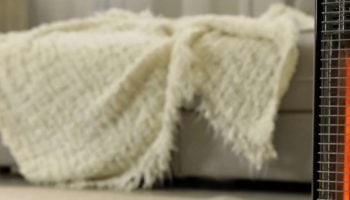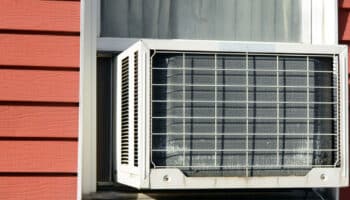We've independently reviewed this article to make sure it's as accurate as we can make it.
To find out more about our article creation and review process, check out our editorial guidelines.
Finding it difficult to breathe every time the AC is on? That nauseous, musty smell could be giving you headaches from mold growths building up inside your window air conditioner!
If you don’t act fast, your air quality could be in jeopardy. Thankfully there are a few easy fixes we can run through to clean and keep mold away.
Here’s a quick summary of how you can clean and prevent mold in your window AC.
- Wash the AC filter.
- Vacuum your AC’s interior.
- Scrub away mold growths with a cleaning solution composed of hot water and mild dish soap.
- Get rid of organic sources of mold in your house.
- Reduce the humidity in your home.
- Fix water leaks.
- Maintain your AC regularly.
Want a more detailed set of instructions? Read on.
How to Clean Mold on a Window Air Conditioner
In any case, it’s always better to prevent problems than to have to solve them.
But if you already have mold in your AC, you have no choice but to proceed with cleaning it up. Worry not, though. I’ve outlined the easiest steps in cleaning your moldy but still precious machine.
First, you should prepare and use the right materials for cleaning.
List of tools and supplies to prepare
- Facemask
- Protective eyewear
- Gloves
- Screwdriver
- Scrub/brush
- Cloth
- Vacuum cleaner (with the necessary attachments)
- Large bucket
- Laundry detergent
- Dish soap (mild only)
- Water
And then here’s what you need to note before you start cleaning up: do it where there’s enough ventilation.
You wouldn’t want to feel suffocated. And, you wouldn’t want to remove the mold only to confine the ugly smell inside your home.
Now here comes the “how.”
How to Remove Mold From a Window Air Conditioner
- Wear your safety gear.
This includes your eyewear, mask, and gloves. Wear them to prevent getting yourself contaminated with anything toxic.
- Turn your window AC off.
Unplug the unit from the primary power source. You wouldn’t want to mess with sparks.
- Move your AC unit to an area where there’s plenty of ventilation.
You also wouldn’t want the dirt and the spores to get stuck inside your living room.
- Remove the front body grille from your window AC.
Usually, you can do this by pulling the grille forward and then pushing it down a little. Of course, you may have to unscrew it first.
- Remove the filter.
If it’s a disposable one, then dispose of it. You can just install a new one. But, if it’s a washable filter, then you can wash it with water and laundry detergent. This brings us to the next step.
- Wash the washable filter in your sink.
Your kitchen sink will do. Just fill the sink with hot water. The volume should just be enough to cover the filter when you put it in there.
Let the filter soak for about 15 minutes. Once done, scrub the filter thoroughly on both sides. Finally, rinse the filter with clean water. Then hang it so it can dry.
- Go back to your AC unit and remove the unit’s metal cover.
This cover would be located behind the AC’s front body grille. You can simply unscrew it and then lift it upward.
- Vacuum the AC’s interior.
You can use the appropriate vacuum hose attachments to suck out dirt from the unit. If you see any mold growth, this is the time to wipe them out.
- Prepare the cleaning solution.
As much as possible, hold your breath while doing so. And be careful with your skin and eyes. Now fill your bucket with the following ingredients.
- 1 tablespoon of mild dish soap
- 3 gallons of hot water
- Scrub the moldy areas with the cleaning solution.
First, dip a piece of cloth, sponge, or brush into the resulting liquid cleaner. Carefully scrub those areas of your AC that got mold in them. If the front grille is especially untidy, then be sure to clean it thoroughly.
- Let the cleaning solution do its work for 10 minutes before rinsing.
That is, you have to let the cleaning ingredients sit on the surfaces. This should allow them to kill the rest of the moldy growth. After the waiting time, rinse the unit with water and a damp cloth.
- Allow all the parts of your AC unit to dry completely.
Make sure the body, the filter, the metal parts, and the grille are all dried out before you move on to the following step. You wouldn’t want to attract the next batch of mold growth by leaving any moisture inside.
- Once everything is dried out, reassemble your unit.
Congratulations! You’re done with the cleaning. Now you can plug the AC back to the power source.
What is Air Conditioner Mold?
Yes, I get that you’re having problems with some nasty stuff that looks “like” mold within your AC. But what really is mold?
I’m sure you’d want to know. After all, you wouldn’t want it to keep coming back, right?
So here’s a little overview of what mold is.
First of all, a mold (or mould) is a fungus. It’s furry. And it grows when these three conditions are present together: an organic substrate, moisture, and warmth.
So mold loves places that are dark and damp. Now that sounds like the inside of your air conditioning unit!
This photo of Comfort Inn Ship Creek is courtesy of TripAdvisor
While there are many types of molds, they all tend to favor damp and humid spaces. Some thrive in air vents and ducts. And many of them are toxic.
Sounds scary, right?
Yes, and here are the other things to be worried about mold growths.
The Problems Air Conditioner Mold Creates
The musty smell appears to be a heavy problem in itself, but it’s not the only troublesome issue about mold.
With your AC continually circulating air throughout your home, it sometimes picks up mold spores, spreading them into your living areas.
As a result, you could suffer from frequent allergy symptoms.
Worse, mold exposure can have moderate to severe consequences on your health. It can give you:
- Headaches
- Asthma attacks
- Chronic cough
- Sneezing
- Discomfort in the eye and nasal passages
- Skin reactions
- Respiratory infections
So it can be quite a serious problem. According to the Environmental Health Perspectives, dampness and mold exposure can increase the risk of respiratory health issues by
Even the process of cleaning up a moldy AC can risk your exposure to mold.
This means you have to be vigilant about preventing mold growths — not just wiping them out.
And vigilance also means detecting mold growths as early as possible.
Is Your AC is Growing Mold?
You don’t need to look inside to notice if a foul smell coming off the AC as you turn it on. People call this the “dirty-sock syndrome.” Simply put, it smells like you’re in a room full of dirty socks! Also, it’s like that locker room odor — it comes off from a locker room that hasn’t been opened and cleaned for a very long time.
So that’s the first thing you’ll notice when mold has infiltrated your air conditioner.
Eventually, you may start feeling the symptoms of respiratory issues that I’ve listed above.
And with the right combination of summer heat, humidity, and precipitation, your AC will likely continue to breed mold.
So how will you prevent mold from wreaking havoc on your AC? And…your personal health?
How to Prevent Mold on a Window Air Conditioner
Luckily for you, there are several ways of keeping moldy growths away from your air conditioning unit. Here are a few tips and tricks.
Keep the AC always on. As much as possible.
It may sound a little impractical, financially speaking. But turning your AC on (even while you’re out) can help against mold growth.
When your AC is not on, moisture will soon build up within the house. The temperature inside may rise, and the air would be stale. All these factors favor the growth of mold, but your AC can keep them all out. Of course, that’s only possible if it stays on.
So, do you really just leave it on? Yes, but turn it into “auto” mode. This function will cycle the air inside and keep it in optimal conditions.
Add a UV filter in your AC.
A UV filter in an HVAC system helps in regulating mold spores. It makes use of ultraviolet light and a high-end filter to trap and destroy allergens.
Thus, a UV filter can help allergy sufferers and asthmatics as it kills bacteria and mold spores in the air.
Get rid of the organic sources of mold in your home.
Dust is one of the substrates that encourage the growth of mold.
So, you need to vacuum regularly to remove the dirt and organic compounds in your carpet and other areas or items in your home where these minute substances can cling.
Fix water leaks.
Water leaks can promote mold growth. In fact, water is probably the most significant contributing factor to mold infestation in your home.
So, you have to choose a good plumber to fix all the leaks in your house. Even the smallest water leaks can breed mold!
Choose a window AC with humidity control.
Sometimes, it’s about the AC itself. Its efficiency. So, in case you’re buying a new AC unit, remember to choose one with humidity control.
This feature allows your AC to suck humidity from your home. Remember, a less humid home will discourage the growth of mold.
Maintain your AC.
Eventually, your AC filter will collect enough dust and dirt to warrant a breeding ground for mold. But, you shouldn’t wait for the smelly signs to appear before cleaning your AC unit.
What you need to do is schedule a monthly filter clean-up. Just follow the steps I’ve outlined above.
Meanwhile, your window AC also needs proper yearly maintenance. You may need to contact a professional service to get this done. An expert should be able to check for duct leaks and other significant issues in your air conditioner.
If your AC unit has too many issues though, you may need to replace it instead of pouring all your money and efforts to fixing it. Check out this guide to know if you should buy a new AC or keep repairing your current one.
Conclusion
Mold growths inside an air conditioning unit are potentially harmful to your health. Your respiratory health, to be specific.
And if you’ve been spotting the signs and feeling sick every time you inhale, then your AC is likely breeding mold. Certain areas in your home may be harbouring mold, too. And your AC could be circulating the spores around and about.
So get rid of the triad — the mold spores, the moisture, and the warmth. Clean up your AC, too. And you should no longer find yourself going “Achoo!”








